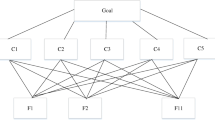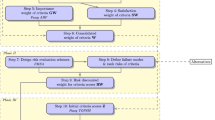Abstract
Upon contaminated to a certain extent, the lubrication oil should be changed for recovery. An effective decision of the waste oil recovery process is in generally affected by factors including the vary testing indices are, contamination level and other limited conditions,called muti-features. To crack this nut, a integrated method was proposed to obtain the dynamical weights to be fused in the DS frame. Firstly, the fuzzy analytic hierarchy process (FAHP) method was proposed to solve the multi-features weights distribution by the decision makers, and the Change-weight method was used to dynamically adjust their weights by the real status, rather than the fixed weights distribution; Further, the schemes supporting information corresponding to every feature is evaluated by each decision maker, and their weights are dynamically calculated too by the joint application of technique for order preference by similarity to ideal solution (TOPSIS). The two types of dynamic weights are regarded as the basic probability assignment (BPA) to fuse the assessment information integrated by the DS theory of evidence. An example of the waste oil recovery-decision is presented to illustrate the application of the method. The effectiveness of the proposed method is validated by the example.



Similar content being viewed by others
References
Balat, H.: Prospects of biofuels for a sustainable energy future: A critical assessment. Energy Educ. Sci. Technol. Part A 24, 85–111 (2010)
Kalipci, E., Ozdemir, C., Sahinkaya, S.: Evaluation of manageable biological waste utilization of Konya in terms of environment and energy recovery. Energy Educ. Sci. Technol. Part A 27, 35–42 (2011)
Jia, R.Q., Wang, L.P.: The research situation and main expectation on the technology of hydraulic contamination control. Hydraul. Pneum. Seals 1, 38–40 (2004)
Demirbas, A.H.: Inexpensive oil and fats feedstocks for production of biodiesel. Energy Educ. Sci. Technol. Part A 23, 1–13 (2009)
Kirtay, E.: The role of renewable energy sources in meeting Turkey’s electrical energy demand. Energy Educ. Sci. Technol. Part A 23, 15–30 (2009)
Kan, A.: General characteristics of waste management: A review. Energy Educ. Sci. Technol. Part A 23, 55–69 (2009)
Demirbas, A.: Social, economic, environmental and policy aspects of biofuels. Energy Educ. Sci. Technol. Part B 2, 5–109 (2010)
Hazar, H., Oner, C., Nursoy, M.: Effects of CrN coating of cylinders on engine performance. Energy Educ. Sci. Technol. Part A 23, 71–85 (2009)
Saidur, R., Lai, Y.K.: Parasitic energy savings in engines using nanolubricants. Energy Educ. Sci. Technol. Part A 26, 61–74 (2010)
Liu, H.W., Wang, G.J.: Multi-criteria decision-making methods based on intuitionistic fuzzy sets. Eur. J. Oper. Res. 179, 220–233 (2007)
Guo, C.X., Guo, H.H.: Approach of multiple attribute group decision making with different forms of preference information. Syst. Eng. Electron. 27, 63–65 (2005)
Jousselme, A.L., Grenier, D., Bosse, E.: A new distance between two bodies of evidence. Inf. Fus. 2, 91–101 (2001)
Liao, C.J., Huang, X.Y., Chai, Y.: A study on the system of decision-making for vehicle collision avoidance based on information fusion. J. Syst. Simul. 16, 1589–1592 (2004)
Wang, Y.M.: The evidential reasoning approach for multiple attribute decision analysis using interval belief degrees. Eur. J. Oper. Res. 175, 35–66 (2006)
Beynon, M.: A method of aggregation in DS/AHP for group decision making with the nonequivalent importance of individuals in the group. Comput. Oper. Res. 32, 1881–1896 (2005)
Yao, S., Guo, Y.J.: An improved method of aggregation in DS/AHP for multi-criteria group decision-making based on distance measure. Control Decis. 25, 894–897 (2010)
Desch, R.G., Kerre, E.: On the relationship between some extensions of fuzzy set theory. Fuzzy Sets Syst. 33, 227–235 (2003)
Yang, T., Zuo, R.: A method of multi-attribute group decision making based on fuzzy distance and evidence theory. Value Eng. 7, 8–11 (2009)
Liu, Y.Z., Jiang, Y.C., Lin, W.L.: Adaptive group decision making method based on fuzzy distance and neural network. J. Syst. Eng. 23, 28–34 (2008)
Chen, J.Z., Xu, J.P.: TOPSIS based interactive multi-attributes group decision making method and its application. Syst. Eng. Electron. 23, 811–813 (2008)
Chen, X., Ma, L.H., Chen, Y.: Study on the assessment level of experts based on ideal point of linguistic assessment matrices. J. Northeaster Univ. 29, 1362–1365 (2008)
Jia, Z.W., Chen, T.R., Li, Y.H.: Target recognition based on multi-sensor information fusion. Syst. Eng. Electron. 25, 276–281 (2010)
Sylviele, H.M., Isabelle, B., Vidal-Madjar, D.: Application of Dempster Shafer evidence theory to unsupervised classification in multi-source remote sensing. IEEE Trans. Geosci. Remote Sens. 35, 1015–1031 (1997)
Beynon, M., Curry, B., Morgan, P.: The Dempster-Shafer theory of evidence: An alternative approach to multi-criteria decision modeling. OMEGA 28, 37–50 (2000)
Ren, H.W., Deng, F.Q.: Research on data fusion fault diagnosis method based Dempster Shafer evidential theory. Syst. Eng. Electron. 27, 471–473 (2005)
Acknowledgements
Thanks to the innovative team of Chongqing university waste oil reuse technologies and equipment and the authors of references. This research was funded by the projects: Chongqing Education Committee Science & Technology protect (KJ2011706), Chongqing university innovation team project (KJTD201019).
Author information
Authors and Affiliations
Corresponding author
Rights and permissions
About this article
Cite this article
Yong, Z., Zhanzheng, W. Dynamic weight-based multi-features fuzzy fusion for recovery-decision of waste lubrication oil. Cluster Comput 22 (Suppl 3), 7603–7610 (2019). https://doi.org/10.1007/s10586-018-2324-7
Received:
Revised:
Accepted:
Published:
Issue Date:
DOI: https://doi.org/10.1007/s10586-018-2324-7




